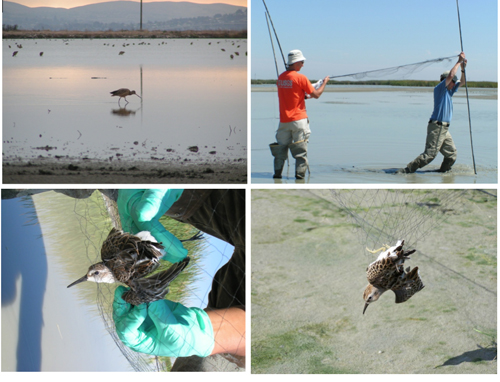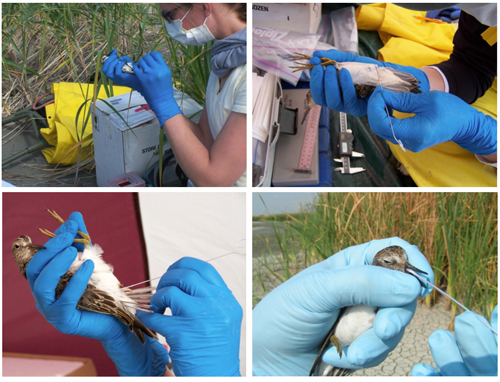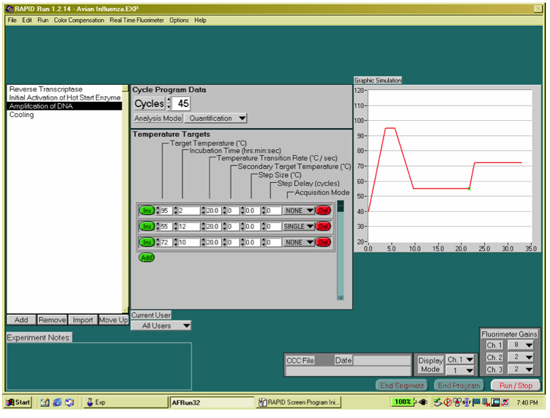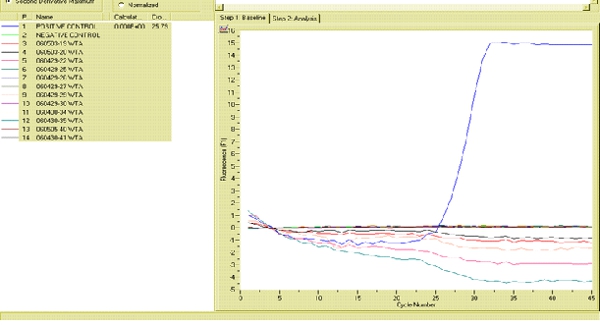A subscription to JoVE is required to view this content. Sign in or start your free trial.
Method Article
Rapid Diagnosis of Avian Influenza Virus in Wild Birds: Use of a Portable rRT-PCR and Freeze-dried Reagents in the Field
In This Article
Summary
This study describes diagnosis of avian influenza in wild birds using a portable rRT-PCR system. The method takes advantage of freeze-dried reagents to screen wild birds in a non-laboratory setting, typical of an outbreak scenario. Use of molecular tools provides accurate and sensitive alternatives for rapid diagnosis.
Abstract
Wild birds have been implicated in the spread of highly pathogenic avian influenza (HPAI) of the H5N1 subtype, prompting surveillance along migratory flyways. Sampling of wild birds for avian influenza virus (AIV) is often conducted in remote regions, but results are often delayed because of the need to transport samples to a laboratory equipped for molecular testing. Real-time reverse transcriptase polymerase chain reaction (rRT-PCR) is a molecular technique that offers one of the most accurate and sensitive methods for diagnosis of AIV. The previously strict lab protocols needed for rRT-PCR are now being adapted for the field. Development of freeze-dried (lyophilized) reagents that do not require cold chain, with sensitivity at the level of wet reagents has brought on-site remote testing to a practical goal.
Here we present a method for the rapid diagnosis of AIV in wild birds using an rRT-PCR unit (Ruggedized Advanced Pathogen Identification Device or RAPID, Idaho Technologies, Salt Lake City, UT) that employs lyophilized reagents (Influenza A Target 1 Taqman; ASAY-ASY-0109, Idaho Technologies). The reagents contain all of the necessary components for testing at appropriate concentrations in a single tube: primers, probes, enzymes, buffers and internal positive controls, eliminating errors associated with improper storage or handling of wet reagents. The portable unit performs a screen for Influenza A by targeting the matrix gene and yields results in 2-3 hours. Genetic subtyping is also possible with H5 and H7 primer sets that target the hemagglutinin gene.
The system is suitable for use on cloacal and oropharyngeal samples collected from wild birds, as demonstrated here on the migratory shorebird species, the western sandpiper (Calidrus mauri) captured in Northern California. Animal handling followed protocols approved by the Animal Care and Use Committee of the U.S. Geological Survey Western Ecological Research Center and permits of the U.S. Geological Survey Bird Banding Laboratory. The primary advantage of this technique is to expedite diagnosis of wild birds, increasing the chances of containing an outbreak in a remote location. On-site diagnosis would also prove useful for identifying and studying infected individuals in wild populations. The opportunity to collect information on host biology (immunological and physiological response to infection) and spatial ecology (migratory performance of infected birds) will provide insights into the extent to which wild birds can act as vectors for AIV over long distances.
Protocol
1. Wild bird capture using mist nets
- For shorebird capture, set up mist nets at an active foraging site such as a marsh, shoreline, or mud flat.
- Slide trammel line loops of one end of the mist net around the pole and insert pole vertically into mud.
- Stretch out net, insert second pole through trammel loops at other end of mist net and vertically insert pole into mud, making sure that the trammel lines are taught.
- Once a bird is captured, extract the bird from the net and return to the banding station.
2. Cloacal swab sampling
- Collect cloacal swabs immediately after capture
- Locate the cloaca and use fingertips to push back surrounding feathers
- Unwrap a sterile Dacron- or Polyester-tipped swab, stem end first, and moisten the tip with sterile viral transport media for greater ease in swabbing. After moistening, the entire head of the swab is gently inserted into the cloaca. Swab the inside circumference of the cloaca by slowly twirling the swab and remove the swab from cloaca.
- Inserting the swab tip directly into the viral transport media sample vial; rotate the swab shaft between the thumb and forefinger while the swab is in the media. Have an assistant complete the procedure by pulling the tip of the swab back from the bottom of the vial ~ 1 cm and cut the shaft of the swab with a pair of scissors so the swab tip remains in the vial and the shaft does not interfere with cap closure. Cap vial tightly. Disinfect the scissors with alcohol in between cutting swab shafts.
- Place the vials in a freezer box containing either dry ice or ice packs.
3. Oropharyngeal swab sampling
- Gently open the bird's beak so that the choanal slit is visible
- Unwrap a clean swab from the package, stem end first, and moisten the tip with viral transport media for greater ease in swabbing
- Without touching the tip to any other surfaces, insert it into the mouth and swab the choanal opening on the roof of the mouth and continue back towards the oropharyngeal or throat region
- Place the swab tip directly into the viral transport media vial. Rotate the swab shaft between the thumb and forefinger while the swab is in the media. As above, have an assistant pull the tip of the swab back from the bottom of the vial ~ 1 cm and cut the shaft of the swab with a pair of scissors so the swab tip remains in the vial and the shaft does not interfere with cap closure. Cap vial tightly. Disinfect the scissors with alcohol in between cutting swab shafts.
- Place the vials in a freezer box containing dry ice or ice packs.
4. Bird handling and release
- Return bird to the site of capture and release in a timely manner (<20mins). Handlers should be aware of the principles of animal welfare and be alert for signs of bird suffering during sampling (i.e. abrasions, capture myopathy and hypo- or hyperthermia). A basic first aid kit should be included in the equipment list.
5. Testing facilities
- Samples can be tested in any enclosed space such as a research trailer or tent, with a power supply (voltage-regulated power generator) to run the PCR unit and attached computer.
6. RNA extraction
- RNA extraction was performed with the RNeasy Mini kit with minor modifications to the manufacturer's instructions following Spackman et al. 1
- Vortex the swab medium for 3-5 s and transfer 350 μl to a 2 ml microcentrifuge tube. Note: Keep remainder sample on ice in case PCR-positive samples need to be rescreened or H5 test needs to be run.
- Add 350 μl of RLT buffer (with β-me) and vortex for 5 s.
- Add 350 μl of RNA grade 70% ethanol.
- Centrifuge at 5,000 x g for 5 min.
- Add 600 μl of the supernatant to a spin column placed in a 2 ml collection tube. Retain the remaining sample in test tube rack.
- Centrifuge for 20 s at 10,000 x g and discard flow-through.
- Repeat steps 17-18 until all the sample has been passed through spin column.
- Place spin column in a clean 2 ml collection tube.
- Add 700 μl of RW1 buffer to the spin column and centrifuge 25 s at 10,000 x g. Discard the flow-through.
- Add 500 μl RPE buffer to the spin column and centrifuge for 25 s at 10,000 x g. Discard the flow-through.
- Repeat step 22 for a total of two washes with RPE buffer.
- Centrifuge the spin column for an additional 2 minutes at 14,000 x g. Discard collection tube.
- Place the spin column in a clean 1.5 ml microcentrifuge tube and add 50μl of nuclease-free water. Incubate at room temperature for 60 s.
- Elute RNA by spinning for 60 s at 10,000 x g for 60 s. Place purified sample on ice.
7. Preparing negative controls
- Lyophilized reagents were prepared for use in the PCR assay according to instructions from the Idaho Technologies Freeze-Dried Reagent Detection Kit for TaqMan Probes Influenza A Target 1 (ASAY-ASY-0109).
- Centrifuge negative control reagent vial (red) for 3 s to ensure pellets are at the bottom.
- Remove cap, visually make sure pellets are at the bottom.
- Add 20 μl of 2 X Reconstitution Buffer and 20 μl Reagent Grade Water.
- Recap and vortex for 5 s at maximum speed.
- Centrifuge for 3 s to bring liquid to bottom of vial.
- Visually check the pellet has rehydrated, if not repeat steps 31-32.
- Pipette 19 μl of the hydrated mixture into a Lightcycler capillary tube, repeat pipette step into a second capillary to obtain a duplicate.
8. Preparing test samples
- Centrifuge the unknown reagent vial (blue) for 3 sec to ensure pellets are at the bottom.
- Remove cap, visually make sure pellets are at the bottom.
- Add 40 μl of purified RNA.
- Recap and vortex for 5 s at maximum speed.
- Centrifuge for 3 s to bring liquid to bottom of vial.
- Visually check the pellet has rehydrated, if not repeat steps 38-39.
- Pipette 19 μl of hydrated mixture into a Lightcycler capillary tube, repeat pipette step into a second capillary to obtain a duplicate.
9. Preparing positive controls
- Centrifuge the positive control reagent vial (green) for 3 s to ensure pellets are at the bottom.
- Remove cap, visually make sure pellets are at the bottom.
- Add 20 μl of 2 X Reconstitution Buffer and 20 μl Reagent Grade Water.
- Recap and vortex for 5 s at maximum speed.
- Centrifuge for 3 s to bring liquid to bottom of vial.
- Visually check the pellet has rehydrated, if not repeat steps 45-46.
- Pipette 19 μl of the hydrated mixture into a Lightcycler capillary tube, repeat pipette step into a second capillary to obtain a duplicate.
10. Centrifuging the capillary tubes
- Once all of the capillary tubes for the batch have been prepared load them into the mini-centrifuge fitted with capillary adapters.
- Centrifuge at the lowest setting by holding the pulse button down for 1 s. This transfers liquid to the bottom in preparation for testing.
11. Operating the RAPID
- Create a New file. Label positive control, negative control, and samples (by their ID number).
- Program 1: RNA Sample Preparation Hold
- Cycles = 1
- Analysis Mode = None
- Target Temperature = 40
- Incubation Time = 30 min
- Temperature Transition Rate = 20°C/s (default)
- Secondary Temperature Target = 0 (default)
- Step Size = 0 (default)
- Step Delay = 0 (default)
- Acquisition Mode = None (default)
- Program 2: RNA Denaturation
- Cycles = 1
- Analysis Mode = None
- Target Temperature = 94
- Incubation Time = 120s
- Temperature Transition Rate = 20°C/s (default)
- Secondary Temperature Target = 0 (default)
- Step Size = 0 (default)
- Step Delay = 0 (default)
- Acquisition Mode = None (default)
- Program 3: RNA Amplification
- Cycles = 45
- Analysis Mode = Auto Analysis
- Target Temperature, Segment 1 = 94; Segment 2 = 60
- Incubation Time, Segment 1 = 0 s, Segment 2 = 20 s
- Temperature Transition Rate, Seg 1 & 2 = 20°C/s (default)
- Secondary Temperature Target, Seg 1 & 2 = 0 (default)
- Step Size, Seg 1 & 2 = 0 (default)
- Step Delay, Seg 1 & 2 = 0 (default)
- Acquisition Mode, Segment 1 = None; Segment 2 = single
- Fluorescence Parameters
- Display Mode: fluorescence channel 2 (Ch2/1)
Gains:- Ch 1 (F1) = 1
- Ch 2 (F2) = 8
- Ch 3 (F3) = 1
- To display the real-time fluorescence data for each sample, select the sample of interest and click the 'Show Graph' button at the bottom of the screen
- Display Mode: fluorescence channel 2 (Ch2/1)
- For each capillary, the results include the following:
- # -- identifies the carousel position of the carousel
- Sample name - provides the name of the sample
- Control - indentifies the sample type for each sample
- Score - calculated using the relationship between the sample's fluorescence and the level of background fluorescence in the sample
- Result - displays the overall result for the sample
12. Representative results:
Possible results include the following:
Present: A red 'present' call for a test/unknown sample indicates that the target was identified in that sample and the controls were successful.
Not detected: A green 'not detected' call for a test/unknown sample indicates that the target was not identified in that sample and the test controls were successful.
Please repeat: A 'please repeat' indicates that the positive or negative control failed.
An example of a successful analysis by the RAPID 7200 is shown in Figure 4. The positive control is amplified and generates detectable fluorescence (y-axis) at approximately 25 cycles (x-axis). A cycle threshold (CT) > 35 is the agreed cut-off for most AIV reference laboratories. Therefore, the positive controls for this method produced a fluorescent signal within the accepted number of cycles (0-35) for AIV detection. In contrast, the negative control does not generate a fluorescent signal even after 45 cycles. Similarly, the twelve samples collected from western sandpipers did not generate a fluorescent signal indicating that the birds were negative for AIV. Follow-up testing of all positive samples in a traditional laboratory is encouraged to ensure that no false positives are erroneously produced.

Figure 1. Shorebird capture using mist nets.

Figure 2. Collection of cloacal and oropharyngeal samples from least sandpipers.

Figure 3. Programming the RAPID 7200 for RNA amplification.

Figure 4. Fluorogram generated by the RAPID 7200 portable rRT-PCR showing how positive and negative controls should appear in a successful assay. Click here to view the full sized image
Discussion
The method of rapid diagnosis presented here facilitates time-efficient and accurate testing of wild bird samples for surveillance of AIV. The much less stringent specimen storage requirements of portable rRT-PCR are suitable for remote situations where maintenance of a cold chain may be impractical if liquid nitrogen shippers or dry ice is not available. In addition, we found that sample analysis with freeze-dried reagents was straightforward enough to be performed by field biologists with minimal knowledge of laborato...
Disclosures
No conflicts of interest declared.
Acknowledgements
We wish to thank M. Scullion and R. Crisp of Idaho Technologies for technical support and the USGS Western Ecological Research Center for funding (S. Schwarzbach) and assistance (K. Spragens, T. Graham). This research was performed under the auspices of the Center for Innovative Technology - Institute for Defense and Homeland Security (www.idhs.org), in support of the Department of Defense and Air Force Research Laboratory. Animal handling followed protocols approved by the Animal Care and Use Committee of the U.S. Geological Survey Western Ecological Research Center and permits of the U.S. Geological Survey Bird Banding Laboratory. Any use of trade, product, or firm names in this publication is for descriptive purposes only and does not imply endorsement by the U. S. government.
Materials
| Name | Company | Catalog Number | Comments |
| RNeasy mini spin column | Qiagen | 74106 | Included in RNeasy Mini Kit |
| Collection tubes (1.5 & 2 mL) | Qiagen | 74106 | Included in RNeasy Mini Kit |
| Buffer RLT | Qiagen | 74106 | Included in RNeasy Mini Kit |
| Buffer RW1 | Qiagen | 74106 | Included in RNeasy Mini Kit |
| Buffer RPE | Qiagen | 74106 | Included in RNeasy Mini Kit |
| RNase-free water | Qiagen | 74106 | Included in RNeasy Mini Kit |
| 14.3 M β-mercapt–thanol solution | Fisher Scientific | BP176100 | |
| 100% ethanol | Fisher Scientific | NC9602322 | |
| Vortex Genie 2, 120V | Scientific Industries Inc. | SI-0236 | |
| Taqman Influenza A Target 1 (Hydrolysis Probe) | Idaho Technologies | ASAY-ASY-0109 | |
| Lightcycler 20ml capillary tubes | Roche Group | 04929292001 | |
| Micro-centrifuge with rotator for 2 ml tubes | Idaho Technologies | Included in RAPID kit | |
| Ruggedized Advanced Pathogen Identification Device (RAPID) 7200 | Idaho Technologies | Included in RAPID kit | |
| Pentium-based laptop with Windows XP Professional | Idaho Technologies | Included in RAPID kit | |
| Lightcycler Data Analysis software | Idaho Technologies | Included in RAPID kit |
References
- Spackman, E. Development of a real-time reverse transcriptase PCR assay for type A influenza virus and the avian H5 and H7 hemagglutinin subtypes. J Clin Microbiol. 40, 3256-3260 (2002).
- Takekawa, J. Y. Field detection of avian influenza virus in wild birds: evaluation of a portable rRT-PCR system and freeze-dried reagents. J Virol Methods. 166, 92-97 (2010).
- Das, A., Spackman, E., Senne, D., Pedersen, J., Suarez, D. L. Development of an internal positive control for rapid diagnosis of avian influenza virus infections by real-time reverse transcription-PCR with lyophilized reagents. J Clin Microbiol. 44, 3065-3073 (2006).
- Spackman, E., Suarez, D. L. Avian influenza virus RNA extraction from tissue and swab material. Methods Mol Biol. 436, 13-18 (2008).
- Chen, R., Holmes, E. C. Frequent inter-species transmission and geographic subdivision in avian influenza viruses from wild birds. Virology. , 383-3156 (2009).
- Macken, C. A., Webby, R. J., Bruno, W. J. Genotype turnover by reassortment of replication complex genes from avian influenza A virus. J Gen Virol. 87, 2803-2815 (2006).
- Dugan, V. G. The evolutionary genetics and emergence of avian influenza viruses in wild birds. PLoS Pathog.. 4, e1000076-e1000076 (2008).
- Spackman, E. Phylogenetic analyses of type A influenza genes in natural reservoir species in North America reveals genetic variation. Virus Res. 114, 89-100 (2005).
- Pasick, J. Advances in the molecular based techniques for the diagnosis and characterization of avian influenza virus infections.. Transbound Emerg Dis. 55, 329-338 (2008).
- . OIE Manual of diagnostics tests and vaccines for terrestrial animals (mammals, birds and bees). 1, 258-269 (2004).
- Weber, T. P., Stilianakis, N. I. Ecologic immunology of avian influenza (H5N1) in migratory birds. Emerg. Infect. Dis. 13, 1139-1143 (2007).
- Kim, J. -. K., Negovetich, N. J., Forrest, H. L., Webster, R. G. Ducks: the "Trojan Horses" of H5N1 influenza. Influenza and Other Respiratory Viruses. , 121-128 (2009).
- Gilbert, M. Flying over an infected landscape: distribution of highly pathogenic avian influenza H5N1 risk in South Asia and satellite tracking of wild waterfowl. Ecohealth. , (2010).
Reprints and Permissions
Request permission to reuse the text or figures of this JoVE article
Request PermissionExplore More Articles
This article has been published
Video Coming Soon
Copyright © 2025 MyJoVE Corporation. All rights reserved